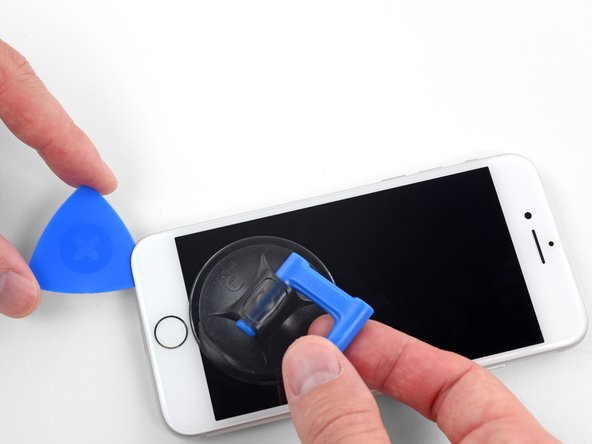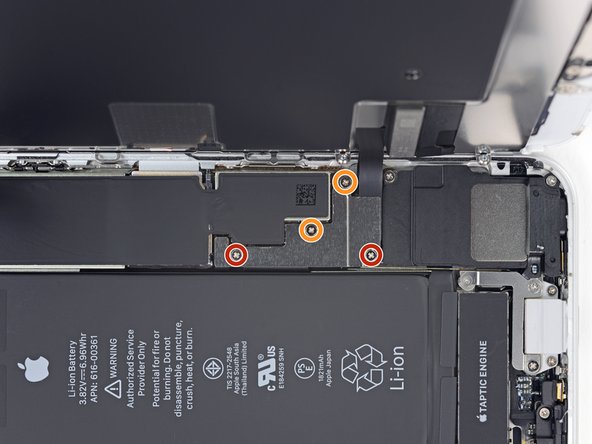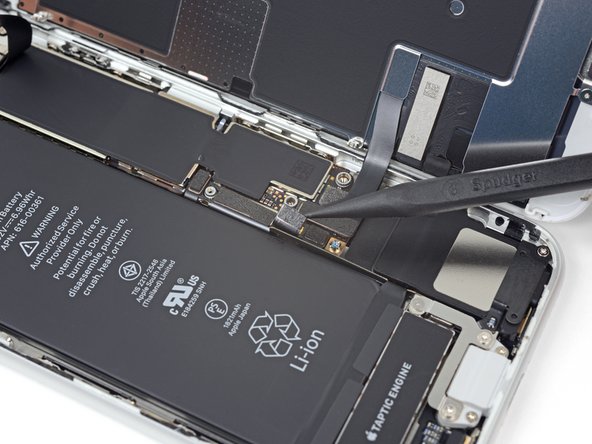iPhone SE 2020 Battery Replacement
Duration: 45 minutes
Steps: 38 Steps
Ready to give your iPhone SE 2020 a battery boost? Swap out that tired battery for a fresh one and get back to peak performance. If you spot a swollen battery, handle with care—it’s not something to mess around with. This guide walks you through removing the display assembly so those delicate display cables stay safe, but if you’re confident you won’t tug on them, feel free to skip those steps. For an easier time with the battery adhesive strips, pop out the Taptic Engine first—this helps prevent accidental snagging or pulling at awkward angles. After your new battery is in, let it charge all the way to 100%, keep it plugged in for a couple more hours, then use your phone until it powers down on its own. Finish up with a full, uninterrupted charge to 100% for best results. If things get tricky, you can always schedule a repair.
Step 1
Before you dive in, let your iPhone battery drop below 25%. Trust us—puncturing a fully charged lithium-ion battery is not the fiery excitement you want.
Shut down your iPhone before you start taking it apart. Nobody needs surprise sparks.
Opening up your iPhone’s display will break its waterproof seals, so be sure to have replacements on hand before moving forward. If you skip this step and reassemble without fresh seals, just be extra cautious around liquids to keep your device dry.
- Unscrew the two 3.5 mm pentalobe screws on the bottom of your iPhone. A simple twist, and you're on your way!
Step 2
Pushing your opening pick in too deep can mess up your device—let’s avoid that! Mark your pick to keep things safe and sound.
Feel free to mark the other corners of your pick with different measurements for extra precision.
Or, stick a coin to your pick about 3 mm from the tip to keep your depth in check.
- Mark the opening pick 3 mm from the tip with a permanent marker to keep your edge sharp and ready.
Step 3
The next three steps introduce the Anti-Clamp—our nifty little tool designed to make opening your device a breeze. If you’re not using the Anti-Clamp, no worries! Just skip ahead three steps for an alternative method.
Need the full scoop on using the Anti-Clamp? We've got you covered with a detailed guide right here.
If your iPhone's surface feels a bit too slippery for the Anti-Clamp to get a grip, a bit of tape on the surface can do wonders and make things stick!
- Gently pull the blue handle back to unlock the Anti-Clamp's arms.
- Slide the arms over the left or right edge of your iPhone—whichever feels right.
- Place the suction cups just above the home button, one on the front and one on the back—right where the magic happens.
- Give the cups a little squeeze to create suction. They’ll hold tight to the surface you’ve chosen, no sweat.
Step 4
- Slide the blue handle forward to lock the arms in place.
- Rotate the handle clockwise a full 360 degrees, or until you notice the suction cups starting to stretch.
- Keep an eye on the suction cups so they stay lined up. If they start to drift apart, just loosen them a bit and reposition the arms to get everything back in sync.
Step 5
Turn no more than a quarter at a time, then take a breather for a minute. Let the Anti-Clamp and a little patience do the heavy lifting!
You can also try using a hair dryer, heat gun, or hot plate—but watch out! Too much heat might harm the screen or battery, so take it easy and be gentle.
If the Anti-Clamp isn’t opening up enough, give the area a bit more heat and twist the handle a quarter turn to get things moving.
- Give your iOpener a warm-up and slide it through the Anti-Clamp's arms.
- Bend the iOpener so it rests nicely on the bottom edge of your iPhone.
- Take a breather for a minute to let that adhesive relax and create a little opening.
- Slip an opening pick into that gap you just made.
- Feel free to skip the next three steps.
Tools Used
Step 6
Up next: three quick moves with a suction cup to get your screen loose and ready for action.
- Warming up the lower edge of your iPhone is a great way to make that adhesive a little more forgiving, so you can pop that display open with ease!
- Grab a hairdryer or an iOpener, and give that lower edge a cozy 90 seconds of heat to loosen up the sticky stuff hiding underneath.
Tools Used
Step 7
Make sure the suction cup stays clear of the home button—otherwise, it won’t stick properly to the front glass and might just bail on you.
- Stick the suction cup onto the lower part of the screen, just above the home button—right where all the magic happens.
Step 8
The adhesive holding the screen in place is pretty tough, so getting that first gap can take a bit of elbow grease. If you're struggling, don’t worry! Just apply a little more heat and gently rock the screen back and forth to weaken the bond. Keep going until you’ve got enough space to slip your tool in and start working.
- Give the suction cup a solid upward tug—steady wins the race! This should open up a small gap between the screen and the frame.
- Slide an opening pick into that new space like a pro.
Step 9
Heads up! Don't yank at the top edge of the display—those sneaky plastic clips are easy to snap. Keep it chill and work gently.
- Grab your trusty opening pick and gently slide it under the left edge of your phone, starting at the bottom and making your way up towards those volume control buttons and silent switch. You're on a mission to break the adhesive's grip on the display!
- Pause your pick adventure just shy of the top left corner of the display.
Step 10
Heads up! There are some fragile cables hanging out along the right edge of your iPhone. Avoid poking your pick there to keep everything safe and sound.
Step 11
Keep your pick to a maximum of 3 mm—going deeper might just tick off the display cables!
- Gently slide your tool into the lower right corner of the iPhone. Now, give it a little wiggle as you move it around the corner and up the right side of the phone to break that adhesive seal. You're doing great!
Step 12
Keep that display at a cool 15º or less, or you might just end up giving those ribbon cables a workout they didn't sign up for!
- Give the suction cup a gentle upward tug to pop up the bottom edge of the screen.
- Grab the little tab on the suction cup and peel it off the front panel like you're removing a fancy sticker.
Step 13
- Gently slide an opening pick under the display at the top left corner and along the top edge of your phone to free up the last bit of sticky adhesive. You've got this!
Step 14
- Gently slide the display assembly down a bit (away from the top edge of the phone) to pop it free from the clips holding it in place against the rear case.
Step 15
Hold off on fully detaching the display just yet! There are still some delicate ribbon cables connecting it to the logic board, so take it slow and steady.
- Pop open the iPhone by lifting the display from the left side, just like flipping open the cover of your favorite book.
- Rest the display against something sturdy to keep it steady while you dive into the phone repair adventure.
Step 16
- Unscrew the four Phillips screws that are holding the lower display cable bracket in place. The screws come in two sizes:
- Pro tip: As you go along, keep track of each screw. They all have their specific spots, and putting them in the wrong place might cause some serious issues when you reassemble. It's like puzzle pieces, just in screw form!
- Now, carefully remove the bracket.
- Two 1.3 mm screws
- Two 2.8 mm screws
Step 17
- Grab a spudger and gently pop the battery connector out of its socket on the logic board. It’s like unplugging your phone’s energy drink.
- Tilt the battery connector cable just a bit away from the logic board—think of it as giving it some personal space—so it doesn’t sneakily reconnect and power up while you’re working.
Tools Used
Step 18
- Grab your trusty spudger and gently nudge the lower display connector out of its snug little home. It's like a game of peekaboo, but with electronics!
- When it's time to pop that connector back in, remember: no middle squishing! Press down on one side until you hear that satisfying click, then do the same on the other side. If it's even a smidge off-kilter, it could bend and cause some serious problems down the line.
Tools Used
Step 19
- Grab your trusty spudger and use its pointy end to gently unplug that second lower display cable. Easy does it!
Tools Used
Step 20
- Unscrew the trio of 1.3 mm Phillips screws holding down the bracket over the front panel sensor connector. Give each one a little twist and set them aside like tiny trophies.
- Lift off the bracket with a flourish—just like revealing the secret level in a game.
Step 21
- Take the pointy end of your spudger and gently pop off the front panel sensor assembly connector—like a little unplug party for your phone.
Tools Used
Step 22
- Take off the display assembly carefully.
- When putting it back together, feel free to pause here if you want to swap out the adhesive around the edges of the display.
Step 23
- Unscrew the three screws holding the bracket next to the Taptic Engine in place:
- One 1.3 mm Y000 screw
- One 2.7 mm Phillips screw
- One 2.9 mm Phillips screw
Step 24
- Take off the bracket carefully.
Step 25
This part of the flex cable is lightly stuck down. If it’s being stubborn, gently warm it up with an iOpener or hair dryer to soften the adhesive. This makes peeling the flex cable off a breeze without any oops moments.
- Carefully slide an opening pick between the antenna flex cable and the top of the speaker, like you're slipping a note into a secret compartment.
Tools Used
Step 26
- Gently use the pointed end of a spudger to lift and unplug the diversity antenna flex cable from the logic board.
Tools Used
Step 27
- Slide an opening pick under the antenna flex cable to keep that socket steady.
- Use the pointed end of your spudger to gently lift and disconnect the antenna flex cable from its socket, while the opening pick holds that socket down like a champ.
- Reattaching this cable might feel like a puzzle, but don’t worry! Grab your tweezers to hold the flex cable in place so it lines up perfectly with the socket. Then, with the flat side of your spudger, press down gently until you hear that satisfying click!
Step 28
- Take out the Wi-Fi diversity antenna and give it a little wave goodbye!
Step 29
If you're in a tight spot, a small flathead screwdriver can save the day! Just remember to be super careful to avoid any slips that might harm nearby components.
The easiest way to get those standoff screws out is with a standoff screwdriver or bit—makes the job a breeze!
- Time to evict the Taptic Engine! Remove the two screws holding it down:
- One 2.1 mm Phillips screw
- One 2.1 mm standoff screw
Step 30
- Gently use the tip of your spudger to lift the antenna cable socket away from the connector nestled below it. You've got this!
Tools Used
Step 31
- Gently use the tip of your spudger to lift and unplug the Taptic Engine flex cable. Take your time, and be careful not to damage anything!
Tools Used
Step 32
Take care when removing the Taptic Engine flex cable—it might be stuck to the antenna flex cable. A little extra patience here goes a long way!
- Lift out the Taptic Engine and set it aside—give yourself a little pat on the back for getting this far!
Step 33
The battery in your iPhone is held in place by four pieces of stretchy adhesive magic—two at the top and two at the bottom. Let's get that power back on track!
- Each adhesive strip has a nifty little black pull-tab at the end, just waiting for you to gently peel it off from the front of the battery. Nice and easy!
Step 34
If you can, try using your fingernails or some blunt tweezers. Just be sure to steer clear of any sharp tools that might poke that battery!
- Gently lift up the first battery adhesive tab from the lower right corner of the battery—like peeling a sticker off your favorite new gadget.
Tools Used
Step 35
Keep those adhesive strips nice and flat! Wrinkles or twists can cause them to stick to each other and break—so keep things smooth to avoid a messy situation.
And hey, don’t press down on the battery while pulling the strips. That pressure can create weak spots that’ll snag and cause the adhesive to snap.
If the strips break underneath the battery and you can't pull them out, no worries! Just remove the remaining strips and keep following the steps below.
The strip can stretch way beyond its original length, so keep pulling! If you need a bit more reach, don't hesitate to grab it again closer to the battery.
- Gently pull one battery adhesive tab away from the battery, heading towards the bottom of your iPhone.
- Keep a steady, smooth pull, maintaining constant tension on the strip until it slides free from between the battery and the rear case. Aim to pull as close to parallel with the surface as possible to avoid catching on any other parts inside the iPhone.
- If the adhesive tabs snap while you're pulling, no worries! Just grab the leftover strip with your fingers or some blunt tweezers and keep pulling until it's all free.
Tools Used
Step 36
If any adhesive strips snapped off under the battery and vanished, no worries—just move on to the next step below.
Keep a good grip on the battery as you peel off that last strip, or it might launch itself out of the iPhone like a rocket!
- Keep the momentum going! Just like before, peel off the other three adhesive strips with care.
- If you've successfully removed all the adhesive strips, you can breeze past the next step!
Step 37
Easy does it—don’t go Hulk-smashing the battery out. If the adhesive’s still hanging on, a few more drops of alcohol can help loosen things up. And let’s keep the battery intact—no squishing or poking it with your pry tool.
If you’re using pry tools to lift the battery, go slow and watch out for the ribbon cables and wireless charging coil hiding just underneath. Gentle hands win the day!
Warm up the iPhone until the back feels pretty toasty (but not so hot it could double as a griddle). Overheating can spark trouble—literally—so keep it safe.
If any of the adhesive strips snapped off and the battery is still glued to the rear case, try dropping a few drops of isopropyl alcohol (90% or higher) under the battery near the stubborn strip(s). Wait about a minute, then gently lift the battery up.
Still stuck? Warm up the rear case right behind the battery using an iOpener or a hair dryer. The heat will soften the adhesive and make lifting easier.
Another trick is to carefully slide a strong string—like dental floss or a thin guitar string—underneath the battery.
To keep your fingers safe and sound, wear gloves or wrap the ends of the string around a tool, such as two screwdriver handles, just like shown in the picture.
- Glide the string back and forth like you’re slicing cheese, working it all the way under the battery to loosen up the sticky adhesive. Just be gentle—keep the battery in shape and out of trouble!
Tools Used
Step 38
- Ready to put everything back together? Just follow the steps backward and make sure to add fresh adhesive before snapping the display back on.
- Got old parts lying around? Drop them off at an R2 or e-Stewards certified recycler to keep things green.
- If your device is still giving you attitude, swing by our iPhone SE 2020 Answers community for some troubleshooting tips. And hey, if you want to skip the hassle, you can always schedule a repair with us.























































































